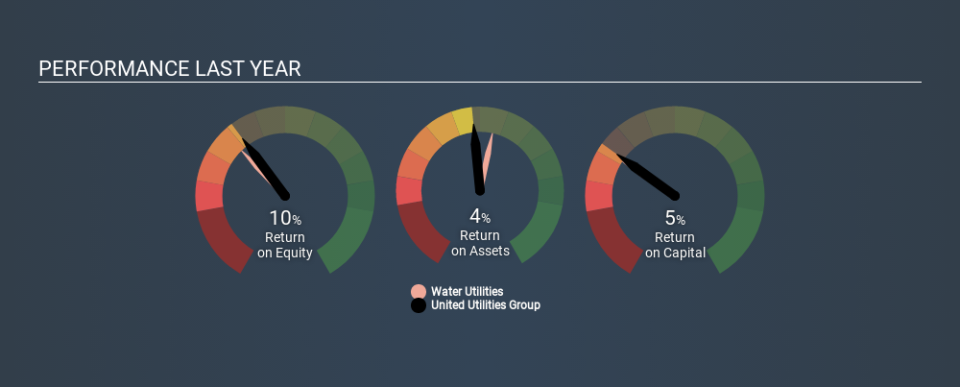Is United Utilities Group PLC’s (LON:UU.) 5.5% Return On Capital Employed Good News?

Today we'll look at United Utilities Group PLC (LON:UU.) and reflect on its potential as an investment. In particular, we'll consider its Return On Capital Employed (ROCE), as that can give us insight into how profitably the company is able to employ capital in its business.
First up, we'll look at what ROCE is and how we calculate it. Second, we'll look at its ROCE compared to similar companies. And finally, we'll look at how its current liabilities are impacting its ROCE.
Return On Capital Employed (ROCE): What is it?
ROCE measures the 'return' (pre-tax profit) a company generates from capital employed in its business. In general, businesses with a higher ROCE are usually better quality. Overall, it is a valuable metric that has its flaws. Author Edwin Whiting says to be careful when comparing the ROCE of different businesses, since 'No two businesses are exactly alike.
So, How Do We Calculate ROCE?
The formula for calculating the return on capital employed is:
Return on Capital Employed = Earnings Before Interest and Tax (EBIT) ÷ (Total Assets - Current Liabilities)
Or for United Utilities Group:
0.055 = UK£714m ÷ (UK£14b - UK£1.1b) (Based on the trailing twelve months to September 2019.)
Therefore, United Utilities Group has an ROCE of 5.5%.
See our latest analysis for United Utilities Group
Is United Utilities Group's ROCE Good?
ROCE can be useful when making comparisons, such as between similar companies. We can see United Utilities Group's ROCE is around the 5.8% average reported by the Water Utilities industry. Aside from the industry comparison, United Utilities Group's ROCE is mediocre in absolute terms, considering the risk of investing in stocks versus the safety of a bank account. Investors may wish to consider higher-performing investments.
The image below shows how United Utilities Group's ROCE compares to its industry, and you can click it to see more detail on its past growth.
When considering ROCE, bear in mind that it reflects the past and does not necessarily predict the future. ROCE can be deceptive for cyclical businesses, as returns can look incredible in boom times, and terribly low in downturns. ROCE is, after all, simply a snap shot of a single year. Since the future is so important for investors, you should check out our free report on analyst forecasts for United Utilities Group.
How United Utilities Group's Current Liabilities Impact Its ROCE
Current liabilities are short term bills and invoices that need to be paid in 12 months or less. Due to the way the ROCE equation works, having large bills due in the near term can make it look as though a company has less capital employed, and thus a higher ROCE than usual. To counteract this, we check if a company has high current liabilities, relative to its total assets.
United Utilities Group has total assets of UK£14b and current liabilities of UK£1.1b. As a result, its current liabilities are equal to approximately 7.7% of its total assets. United Utilities Group reports few current liabilities, which have a negligible impact on its unremarkable ROCE.
The Bottom Line On United Utilities Group's ROCE
If performance improves, then United Utilities Group may be an OK investment, especially at the right valuation. You might be able to find a better investment than United Utilities Group. If you want a selection of possible winners, check out this free list of interesting companies that trade on a P/E below 20 (but have proven they can grow earnings).
If you like to buy stocks alongside management, then you might just love this free list of companies. (Hint: insiders have been buying them).
If you spot an error that warrants correction, please contact the editor at editorial-team@simplywallst.com. This article by Simply Wall St is general in nature. It does not constitute a recommendation to buy or sell any stock, and does not take account of your objectives, or your financial situation. Simply Wall St has no position in the stocks mentioned.
We aim to bring you long-term focused research analysis driven by fundamental data. Note that our analysis may not factor in the latest price-sensitive company announcements or qualitative material. Thank you for reading.



